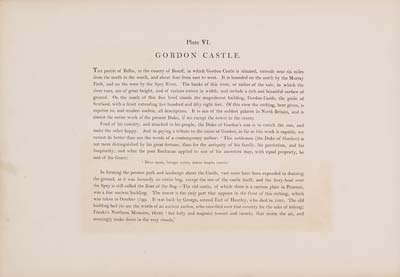(17) Plate VI/a
Download files
Individual page:
Thumbnail gallery: Grid view | List view

Plate
VI.
THE parish of Bellie, in
the county of Bamff, in which Gordon Castle is situated, extends
near six miles
from the north to the south, and about four from east to west. It
is bounded on the north by the Murray
Firth, and on the west by the Spey River. The banks of this river,
or rather of the vale, in which the
river runs, are of great height, and of various extent in width;
and include a rich and beautiful surface of
ground. On the south of this fine level stands the magnificent
building, Gordon Castle, the pride of
Scotland, with a front extending five hundred and fifty eight feet.
Of this view the etching, here given, is
superior to, and renders useless, all description. It is one of the
noblest palaces in North Britain, and is
almost the entire work of the present Duke, if we except the tower
in the centre.
Fond of his country, and
attached to his people, the Duke of Gordon's aim is to enrich the
one, and
make the other happy. And in paying a tribute to the name of
Gordon, as far as this work is capable, we
cannot do better than use the words of a contemporary author: 'This
nobleman (the Duke of Gordon) is
not more distinguished by his great fortune, than for the antiquity
of his family, his patriotism, and his
hospitality; and what the poet Buchanan applied to one of his
ancestors may, with equal propriety, be
said of his Grace:
'Dives opum, luxuque carens, domus hospita cunctis.'
In forming the present
park and landscape about the Castle, vast sums have been expended
in draining
the ground, as it was formerly an entire bog, except the site of
the castle itself; and the ferry-boat over
the Spey is still called the Boat of the Bog.—The old castle, of
which there is a curious plate in Pennant,
was a fine ancient building. The tower is the only part that
appears in the front of this etching, which
was taken in October 1799. It was built by George, second Earl of
Huntley, who died in 1501. The old
building had (to use the words of an ancient author, who travelled
over that country for the sake of fishing;
Franks's Northern Memoirs, 1658) 'her lofty and majestic towers and
turrets, that storm the air, and
seemingly make dents in the very clouds.'
Set display mode to:
![]() Universal Viewer |
Universal Viewer | ![]() Mirador |
Large image | Transcription
Mirador |
Large image | Transcription
Images and transcriptions on this page, including medium image downloads, may be used under the Creative Commons Attribution 4.0 International Licence unless otherwise stated. ![]()
| Scotia depicta > (17) Plate VI/a |
|---|

